SOUTHed Geopolitics without losing good ORIENTations
Time, space, place and education![]()
SOUTHing: a new reading of the World
Marcio D’Olne Campos
SOUTHing is a proposal started in the 90s aiming to critically contextualize notions and practices on spatial orientation taught in the South Hemisphere. In general, traditional techniques that we use to locate ourselves in space are imported from the North without, at least, a proper re-contextualization. That is why we will work here with concepts that go beyond spatial aspects (geographic, cartographic and astronomic), discussed at first. Once North and South (as sociocultural and economical categories) transcend cartography and the division into two Hemispheres, we will also address ideological and geopolitical consequences of the orientation choices.
SOUTHing proposes a critique to the coloniality[1] configured in several ways of dominations of knowledge and power. Those have been perpetrated since the “discovery” (or inauguration) of the Americas and later reinforced by the modernization of the lifestyle, production and mercantilization. In opposition, we want to contribute to the recognition and importance of the existence of different identitary consciences, as well as to the communication and cognition processes. These processes must be marked by reciprocity and respect for the socio-cultural diversity of all populations on the globe.
It is up to us to think of a SOUTH free of hegemonies and dominations of power and knowledge, a South that can produce a critical conscience and also becomes the developer of important actions for populations that live in subaltern conditions. Such conditions exist even in the Northern Hemisphere, which is generally represented as the upper hemisphere on the vast majority of terrestrial globes and world maps available on the market.
Discussions on dualities and oppositions related to this introduction will appear throughout the website. In particular, our friend and Mexican anthropologist Mariano Baez will emphasize a discussion on geopolitical aspects in his in his text “Seeking an upsided North”.
We will also try to develop habits of observing and “digging” some phenomena, ways of thinking, doing and acting, often originated in other natural and social contexts, as well as foreign to our ways of living and reading the world. Habits and phenomena, or ways of acting and thinking that have been rooted in such a way that conditioned us to accept without a deep critical reflection on what is “imported”. Thus, we live with foreign knowledge and doings as if they were ready to integrate the daily routine of our natural and social environment. Later on, we will discuss the importance of directions of spatial orientation that derive from the cardinal points and the artifacts used to find them.
As general proposal, SOUTHing is to reflect and act on it, it is to insist on a critical reinterpretation of the world, where, for example, terrestrial globes and maps in which the South always appears on the underside – or “lower” Hemisphere. We must therefore devote ourselves to scrutinize our surroundings and, instead of tacitly accept what is or has been taught to us. It is necessary to problematize. We must create problems during our reading of the world, even when the solution seems obvious. It is essential to always think about the obvious that was not thought of.
You will find some of these questions throughout the website and in particular in “Shortcuts”. For now, let us keep SOUTHing ourselves with cardinal points.
Notes
[1] Colonialidade: Edgardo Lander, A colonialidade do saber: eurocentrismo e ciências sociais. Perspectivas latino-americanas, CLACSO, Buenos Aires, 2005 (278 pags) http://biblioteca.clacso.edu.ar/
SOUTHing vs NORTHing![]()
ORIENTations
Since the earliest civilizations, humans have contemplated and been guided by stars to reckon time, as well as for their social organization (government, hunting and gathering, agriculture, rituals), navigation and other purposes. There has also always been a need for spatiotemporal perception and spatial orientation.
Being spatially ORIENTed on planet Earth means knowing – in an approximate way – how to locate one of the cardinal points towards the ORIENT or sunrise: the EAST.
In general, to be situated or guided indistinctly in both Hemispheres it is taught that we must start from the rising sun. On the contrary, for the night, we turn to different stars in each of the hemispheres. It is at this point that tensions arise between what is taught and what can be observed in each of the hemispheres, as we will discuss below.
Being at the North half of the Planet
In the North, the right hand is pointed towards the rising sun side, the EAST side. Thus, considering the plane of the horizon, the other three perpendicular directions or the other cardinal points are associated: North, West (or W) and South. This rule places us facing the North, concretizing the acts of ORIENTing and NORTHing. If we are in the Northern Hemisphere at night, the North direction is confirmed by seeing the Pole Star almost coinciding with the point at which the polar axis of the Earth (S-N) “pierces” the sky. This is the North Celestial Pole (NCP), justifying the name assigned to the star. From there, pointing to the Pole Star and lowering the hand to the horizon, the geographic north direction is found.
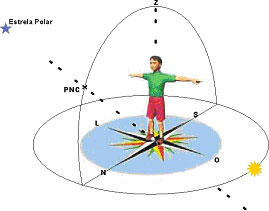
Being in the South half of the Planet
At night, in the Southern Hemisphere, the Pole Star cannot be seen, because it is always below the horizon. Due to that, the Southern Cross constellation is used, which because of the rotation of the Earth, circulates around the South Celestial Pole (SCP), and always presents the longer arm of the cross pointing to the center of the circle, the SCP. From this point, the geographic south direction is defined in the horizon [1]. This act – suitable to the Southern Hemisphere – is to SOUTHing. It is evident that from this nocturnal reference, the other cardinal points can also be deduced.
Note that to observe the Southern Cross constellation we should look to the South, but for this observation to be possible we will be with our left side facing East, the Orient. Thus, in order to situate and adapt our guidelines to the Southern Hemisphere, the practical sunrise rule must be changed. In this case, now pointing the left arm to the side of the sun, we will finally have the South in front of us allowing, coherently, to observe the Southern Cross at night.
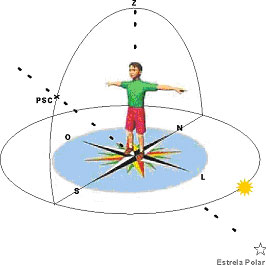
This way, being day or night, we may employ the same body scheme (FIGURE 2). The coherence between, on the one hand, what is observed day and night in the South and, on the other hand, the practical rules of orientation that should be taught in schools is reestablished. Thus, these rules would no longer be those “imported” and unfit for the Southern Hemisphere, presented and printed in published textbooks – at least in Brazil.
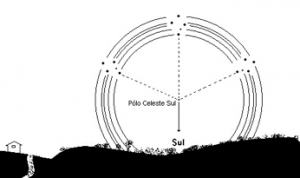
http://www.cdcc.sc.usp.br/cda/ensino-fundamental-astronomia/parte1a.html
When the Southern Cross (SC) is higher in its passage through the S-N meridian, it directly indicates the southern geographic direction as it appears in the central position (figure on the side). In this case, the extension of the greater arm of the cross intersects the direction of the geographical south on the horizon. Since this position is a particular case of the SC circulation, to understand SOUTHing in general, we will first have to determine the position of the South Celestial Pole (SCP).
It is known that the SCP is at a distance of 4.5 times the length of the longest arm of the cross, counted from the brightest star at the foot of the cross (α Crucis or “Star of Magellan”). With the arm stretched and using the thumb and forefinger to include the length of the longer arm, it aligns itself by four and a half times that distance from the α Crucis finding the SCP.
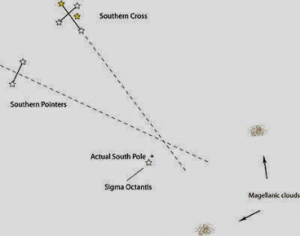
http://2.bp.blogspot.com/
By another method, it is known that the shorter arm of the SC, as well as the two stars (α and β Centauri) that come after it, lies in the same imaginary circle already mentioned whose center is the SCP. It is just needed to imagine the bisectors of these two line segments between each of the two stars being extended so that their intersection will occur in the center of the circle, that is, the SCP.
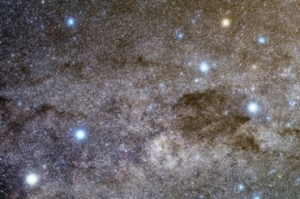
The figure above shows the photo of SC together with α and β Centauri.
Notes:
[1] Geographic south direction: It can be imagined that the two stars of the smaller arm of the cross lie in a concentric circle with the SCP. In this circulation, alpha and beta stars of the Centauri constellation (α and β Centauri) precede these two stars. If we imagine the perpendicular bisectors of the line segments joining these two stars, they will meet precisely in the SCP. From there, pointing and lowering the arm to the horizon we will have the geographical South.
http://www.casadaciencia.ufrj.br/
http://www.comciencia.br/ (2001)
Observatório Dietrich Schiel – Centro de Divulgação de Astronomia:
The South and the reconquest of its referents![]()
The society/nature, North/South and sky/earth relations, as well as the hegemony of the Northern Hemisphere, are part of some of the discussions on this site. In building and/or strengthening an identity related to those living in the Southern Hemisphere, it is very important that we seek our referents, that is, everything that concerns us.
This search for referents of the Southern Hemisphere has motivated several important manifestations. One of them is the “School of the South”, proposed by the Uruguayan artist and intellectual Joaquin Torres Garcia (1874-1949).
The excerpt that follows is exemplary and connected to its illustration bellow: the reversed map [1] drawn by Torres Garcia.
Notes:
[1] Reversed map
Australia is an important reference center for reversed maps (upside-down maps), which have been diffused among us through world maps based on the “Peters Projection”. These maps not only showed the real areas of the continents’ surfaces on Earth, but were also edited by reversing the traditional North and South positions (Campos 2016). In such cases, if someone says that the map is upside-down or reversed (or with the head downward, like we say in Brazil, corresponding to a body upside-down), he or she, will be – in a certain sense – thinking of a “head” in the North. With this, if the normal would be the head/thought in the North and above, we could imagine that the knowledge and practices drained from North to the South (inferior) would be “swallowed” without any thinking/reflecting in the local context.
In the following, some are cited:
– South-up map orientation
https://en.wikipedia.org/wiki/South-up_map_orientation
– North–South divide
– The Upsidedown Map Page
It needn’t be a Eurocentric world
https://www.flourish.org/upsidedownmap/
The School of the South – La Escuela del Sur
Joaquin Torres Garcia (1935)
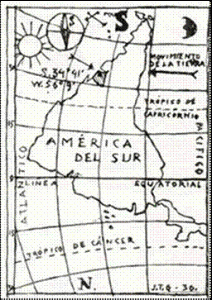
– Reversed map of America – Joaquín Torres García Fonte: TORRES-GARCÍA, 1935
“A great School of Art ought to arise here in our country. I say it without hesitation: here in our country. And I have my reasons for affirming this.
I have said School of the South; because in reality, our North is the South. There should be no North for us, except in opposition to our South.
That is why we now turn the map upside down, and now we know what our true position is, and it is not the way the rest of the world would like to have it.
From now on, the elongated tip of South America will point insistently at the South, our North. Our compass as well; it will incline irremediably and forever toward the South, toward our pole.
When ships sail from here traveling north, they will be traveling down, not up as before. Because the North is now below. And as we face our South, the East is to the left.
This is a necessary rectification; so that now we know where we are.”
References
CAMPOS, M. D. Por que SULear? Astronomias do Sul e culturas locais. In Perspectivas Etnográficas e Históricas sobre as Astronomias, Priscila Faulhaber, Luiz C. Borges (Orgs.), Anais do IV Encontro Anual da SIAC. Rio de Janeiro: Museu de Astronomia e Ciências Afins (MAST), 2016, p. 215-240. http://www.mast.br/publicacoes_do_mast.html#letra_p. Acesso em 1 nov 2016.
TORRES-GARCIA, Joaquín, The School of the South (Uruguay, February 1935). In: RAMÍREZ, Mari Carmen. (Ed.). El Taller Torres-García: the School of the South and its legacy. Austin: University of Texas Press, 1992 p 53-57.
Seeking an upsided North [1]![]()
Mariano Baez
Anthropologist
CIESAS Golfo, Xalapa, MX
The knowledge produced from the central countries comes from a North located at the upper half of the globe, which is often accepted without adequate reflection and above all without taking into account the diversity of local realities, daily routines of their territories and their cultures. The referents created by visions and ideologies from the North to the South involve racial, ethnic, religious, social and economic aspects, the text of the Argentine philosopher Arturo Andrés Roig [2] (2002) attests to its importance.
The inequalities marked by polarity between the two Hemispheres exist and are systematically affirmed. The design of the terrestrial globes show a dominant verticality of the North with the world, reason why installs in them a base or foot that does not have sense but to emphasize the superior position of the North, in such a way that those that inhabit the Southern hemisphere Appear in a lower position, “below” the equator [3] [4].
The project and construction of “northern” museums on the cultures of the South testifies to a vertical and racist view, which comes to light in the case of museographic productions conceived on the basis of a shared curatorial model, where can be verified the importance of adoption of a different point of view in the design and function of the museographic work that has as a starting point the eyes of the people themselves and their cultures in the conception and assembly of their own exhibitions.
Mexicans, in another example, speak of an upsided North when they refer to “norteados” (guided northward) as the disoriented people, who lost their way.
The South is not only a historical and geographical reference, but it can become a tool to produce different knowledge and social, intercultural, symmetrical, emancipating relations within human diversity. Building this South, avoiding any kind of hegemony and relations of power, implies thinking beyond ethnicities, cultures, races, religions, borders and living together with the great human diversity. We think of a South that not only locates entire nations geographically, but also encompasses those who live in a marginal and subaltern condition within the Northern Hemisphere itself.
“SOUTHing” is a proposal to think and represent the world in a different way, an alternative to the global hegemony of racial, ethnic, geographic-political and economic Norths that have built frontier walls that separate people, instead of bridges that allow them to transit, communicate and live together. Borders are highly dynamic territories of cultural exchange.
To be able to “SOUTHing”, that is, to trace intercultural and interethnic trajectories looking for non-hegemonic, emancipatory referents that foster recognition, respect and coexistence among ALL possible worlds, new ways of thinking are needed that “turn the world upsided down” and recognize every possible SOUTH.
To SOUTH, “SOUTHing”
(SULear, SULeando / SURear, SUReando as in Portuguese/Spanish)
SOUTHing, therefore, leads us to promote social relations, intercultural and interethnic basically, which pursue the negotiation between several strategies of cultural control (Bonfil 1991) {10} that were originally expressed under tension and with a degree of asymmetry whose origin is in the same nature of social relations in capitalism.
SOUTHing is not mediating and/or translating relations between different cultural and mental contexts. It is creating open, frank, transparent and friendly communicative processes that guarantee coexistence based on respect for human diversity.
SOUTHing is a proposal to think and represent the world in a different way, alternatively to the global hegemony of cultural, racial, geographic-political, economic and vertical Norths. It is not a celebration of the oppressed, nor a victimization of the dispossessed, it is an invitation to celebrate a horizontal globalization.
Rio de Janeiro, March 13, 2016
Notes
[1] Text from greatful conversations between Mariano Báez Landa (CIESAS, México), Marcio D’Olne Campos (UNIRIO, Brasil) y Luis Carlos Borges (MAST, Brasil).
[2] Roig, Arturo Andrés. “Pensar la mundialización desde el sur”, en Huellas : búsquedas en artes y diseño, Nº 2, pp. 15- 20. Dirección URL del artículo: http://bdigital.uncu.edu.ar/ (Acceso en13/03/16).
[3] Benedetti,Mario “El Sur también existe” http://www.poemas-del-alma.com/ (Acceso en 13/3/2016)
[4] Campos M. D. SURear, NORTEar Y ORIENTar: Puntos de vista desde los hemisferios, la hegemonía y los Indígenas, capítulo 33 In Practicas Otras de Conocimiento(s): Entre crisis, entre guerras, Xóchitl Leyva et al. (orgs), Cooperativa Editorial Retos, San Cristóbal de Las Casas, Chiapas, México. 2015. Pp. 433 – 458.
Campos M.D.“SULear vs NORTEar: Representações e apropriações do espaço entre emoção, empiria e ideologia”. Série Documenta, año VI, núm. 8. EICOS, Cátedra UNESCO de Desenvolvimento Durável, UNIRIO, Río de Janeiro, 1997 pp. 41-70, http://www.sulear.com.br/texto03.pdf acceso em 14-03-2016
